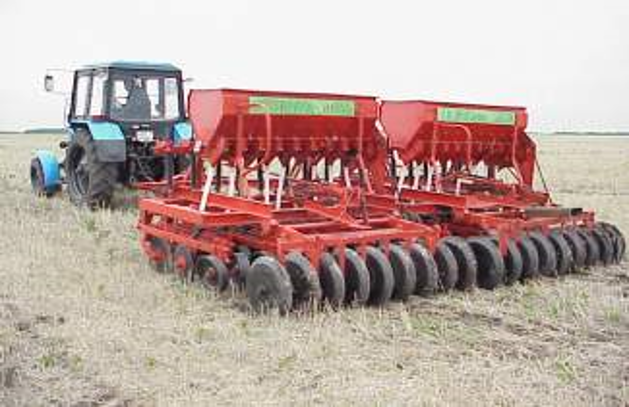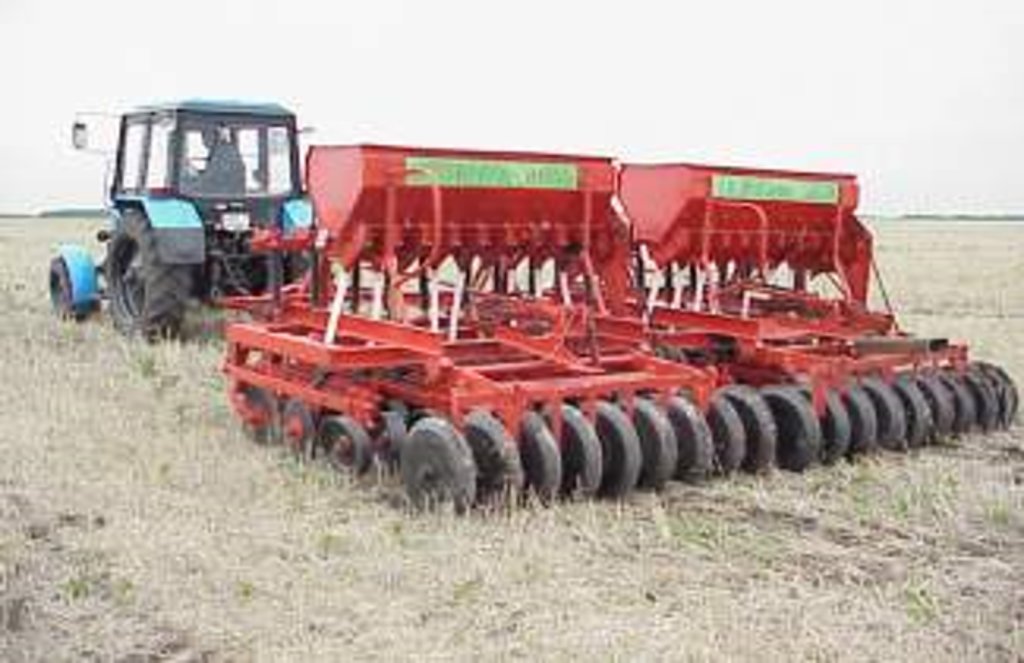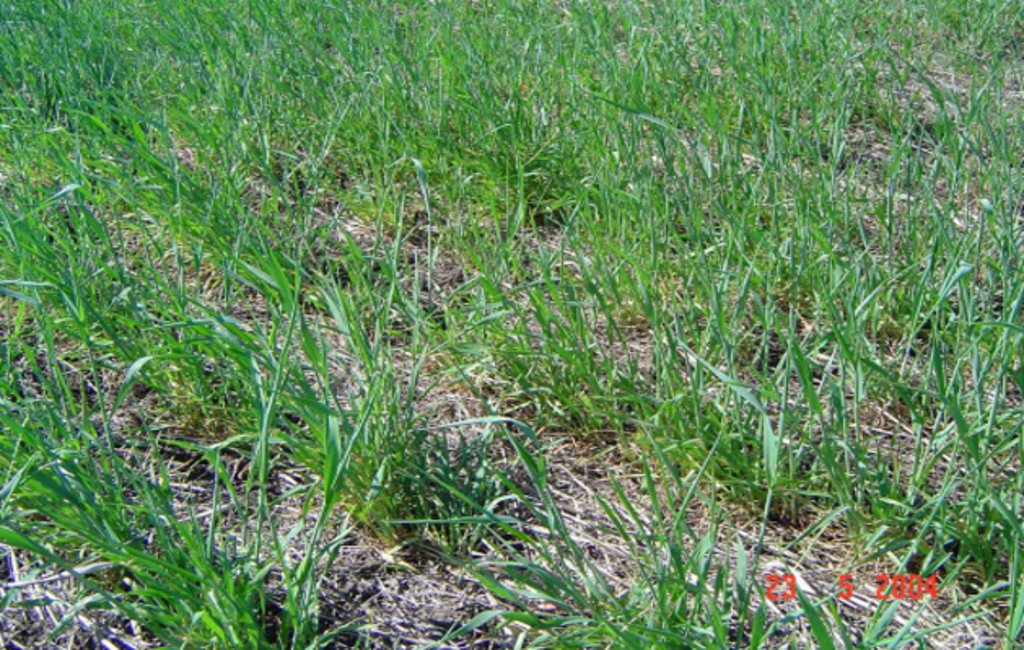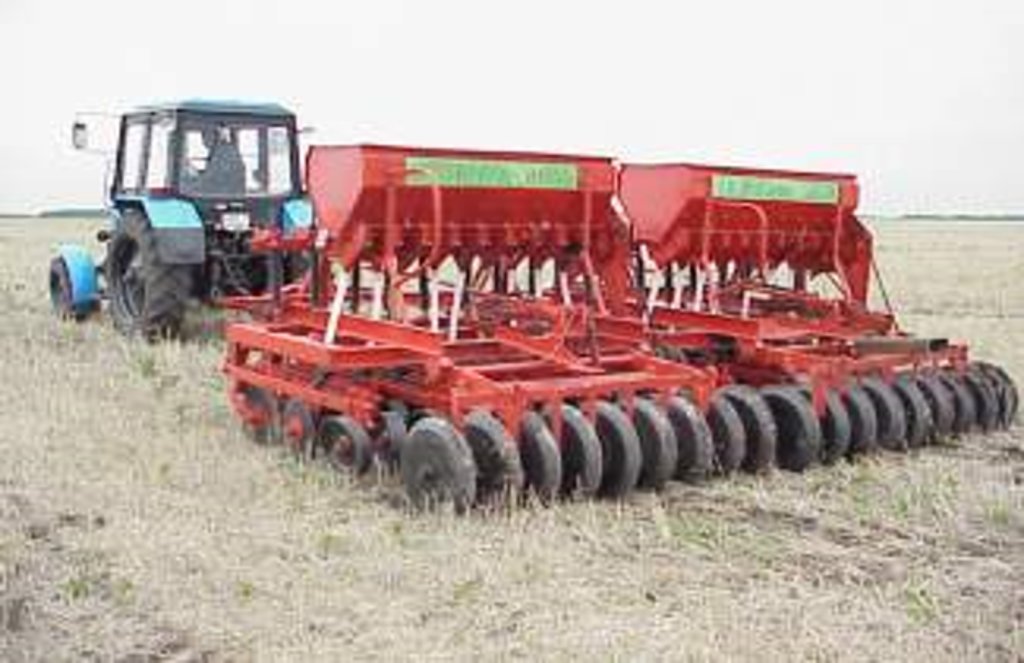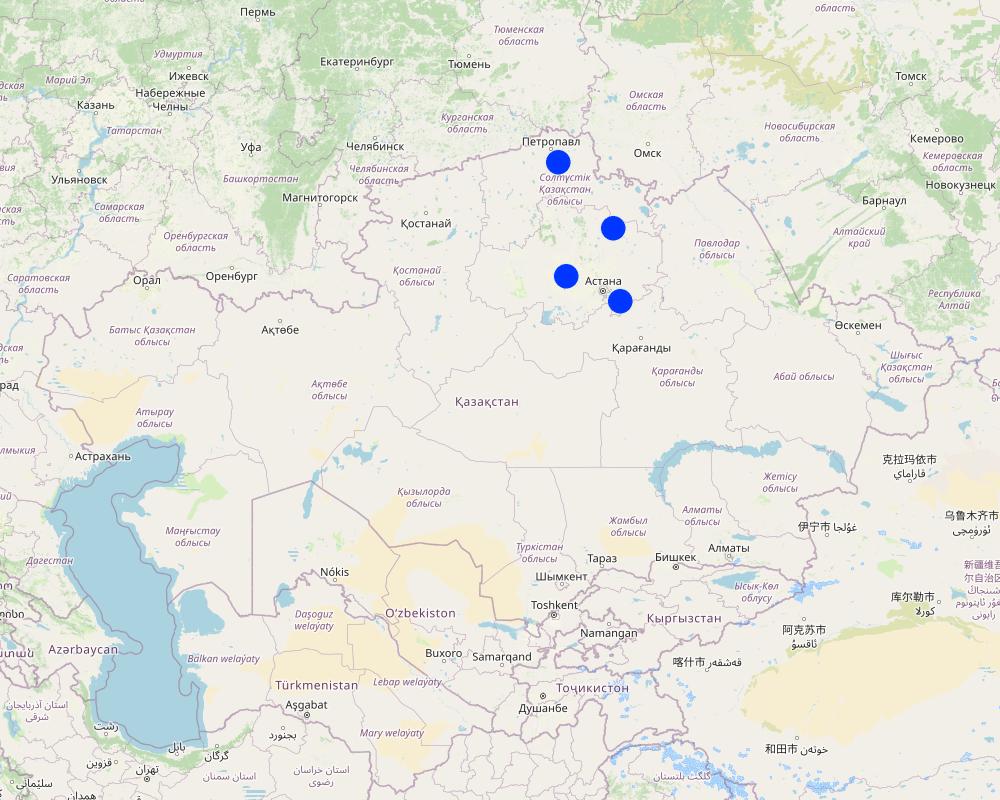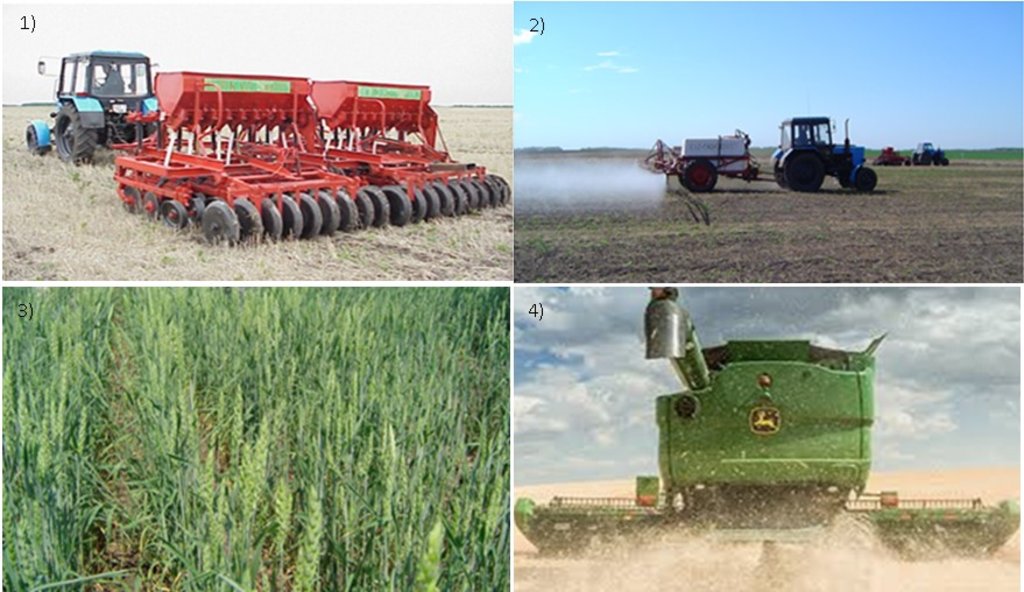Conservation Agriculture for cereal production in rainfed areas of Kazakhstan [Cazaquistão]
- Criação:
- Atualização:
- Compilador/a: Kulyash Iskandarova
- Editor: Hayot Ibrakhimov
- Revisor: Rima Mekdaschi Studer
Conservation Agriculture for cereals production in rainfed agriculture lands
technologies_5673 - Cazaquistão
Veja as seções
Expandir tudo Recolher tudo1. Informação geral
1.2 Detalhes do contato das pessoas capacitadas e instituições envolvidas na avaliação e documentação da tecnologia
Pessoa(s) capacitada(s)
Expert/Consultant:
Karabayev Muratbek
CIMMYT-Kazakhstan
Cazaquistão
Nome do projeto que facilitou a documentação/avaliação da Tecnologia (se relevante)
Integrated natural resources management in drought-prone and salt-affected agricultural production landscapes in Central Asia and Turkey ((CACILM-2))Nome da(s) instituição(ões) que facilitou(ram) a documentação/ avaliação da Tecnologia (se relevante)
Kazakh Research Institute for Livestock and Fodder Production (Kazakh Research Institute for Livestock and Fodder Production) - Cazaquistão1.3 Condições em relação ao uso da informação documentada através de WOCAT
O/a compilador/a e a(s) pessoa(s) capacitada(s) aceitam as condições relativas ao uso de dados documentados através da WOCAT:
Sim
1.4 Declaração de sustentabilidade da tecnologia descrita
A tecnologia descrita aqui é problemática em relação a degradação da terra de forma que não pode ser declarada uma tecnologia de gestão sustentável de terra?
Não
Comentários:
The technology helps to restore degraded land
1.5 Referência ao(s) questionário(s) sobre abordagens GST (documentado(s) usando WOCAT)
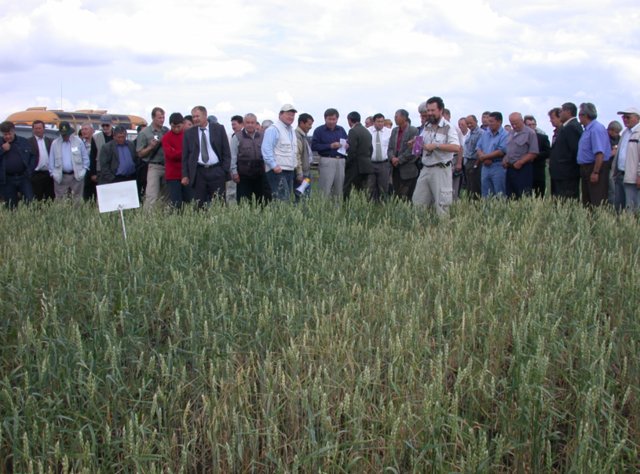
Awareness Raising for SLM Using Conservation Agriculture [Cazaquistão]
Raising awareness and strengthening the capability and skills of farmers, agriculture specialists and researchers in developing and adoption resource-saving, profitable and environmentally friendly cereal production through Conservation Agriculture practices.
- Compilador/a: Kulyash Iskandarova
2. Descrição da tecnologia de GST
2.1 Descrição curta da tecnologia
Definição da tecnologia:
Conservation agriculture applied in Northern Kazakhstan is based on no-tillage direct sowing of cereals into the soil permanently covered by crop residues. It contributes to reverse soil degradation, enhance water use efficiency, increase crop productivity in the rainfed lands.
2.2 Descrição detalhada da tecnologia
Descrição:
The cropping system in Northern Kazakhstan is based mainly on continuous wheat production using conventional technologies. Negative components of this system are intensive tillage, returning little organic matter to the land and monoculture. This system has led to soil degradation (wind and water erosion), soil fertility loss, boost-up of diseases, weed infestation and other problems.
Conservation Agriculture (CA) involves removing these negative components of conventional farming systems and includes three basic principles: 1) minimal soil disturbance, 2) permanent soil cover with crop residues and 3) crop rotation.
In accordance with these principles,
Conservation Agriculture technology includes 3 main operations:
1. Sowing with simultaneously soil fertilization using direct seeder.
2. Post-sowing (after 1-2 days) treatment by non-selective herbicide
3. Harvesting combined with simultaneous plant residues chopping and spreading
For comparison Conventional technology includes 7 operations:
1. Deep fall soil tillage (25 cm).
2. Early spring soil treatment.
4. Pre-sowing soil treatment.
5. Sowing with simultaneously soil fertilization using conventional seeder.
6. Selective herbicide application 2,4-Dichlorophenoxyacetic acid (2-4-D).
7. Harvesting.
The CA technology was applied in four farms in Akmola and North-Kazakhstan oblasts:
1.Farm “DARYN”, village Valikhanovo, Zharkainsky rayon, Akmola oblast, Kazakhstan.
2.Farm “Surayev”, village Vishnevka, Arshalinsky rayon, Akmola oblast, Kazakhstan.
3.Farm “Dostyk”, village Astrahanovka, Arshalinsky rayon, Akmola oblast, Kazakhstan.
4. Farm “Cherezdanov”, village Smirnovo, Akkayinskii rayon, Northern Kazakhstan oblast, Kazakhstan.
Depending on the capability of these four farms in total 330 ha agricultural land were allocated for the testing and adaptation of the technology. On each farm, field trials under equal conditions (soil, temperature, humidity, landscape, etc.) were conducted and included 2 treatments: Conventional (7 operations) and Conservation Agriculture (3 operations).
Analysis of 2002-2004 trials data demonstrated that yield of wheat and other cereals under CA technology was in average 15-25% higher in comparison with the conventional technology. The advantages of CA technology are especially evident in the years of drought (up to 40% in dry 2004 year). Economic evaluation of the technology made by two independent experts from Kazakhstan (Kazakh Research Institute for Grain Farming) and USA (Idaho State University) suggested that costs of labor, fuel, repairs and spare parts as well as machinery and equipment wearing-out under the Conservation Agriculture technologies is significantly lower as compared to those of traditional technology. In general, it is important to emphasize that the experience of the CA adaptation in North Kazakhstan helped farmers/land-users:
•To determine the appropriate level of tillage in a cropping system that is feasible with direct sowing and CA technology requirements as a potential goal.
•To retain sufficient residue on the soil surface to reduce soil erosion, enhance crop/water productivity, improve soil fertility (because of plant organic material bioprocessing in the soil) and better ensure long term, sustainable production.
•Employ economically viable, diversified crop rotations that can improve cropping system productivity and offer farmers new options to reduce risk that is extremely important for the conditions of Northern Kazakhstan relating to the area of risk farming.
The introduction of the technology for cereal production in the rainfed areas of Kazakhstan was realized within the framework of the FAO/TCP/KAZ/2801 (T) Project “Conservation Agriculture for Sustainable Crop Production in Northern Kazakhstan”, under active cooperation with counterparts: Ministry of Agriculture of the Republic of Kazakhstan (MoA RK), FAO, CIMMYT, Union of Farmers of Kazakhstan (UFK), national agriculture research organizations.
2.3 Fotos da tecnologia
2.4 Vídeos da tecnologia
Comentários, breve descrição:
not available
2.5 País/região/locais onde a tecnologia foi aplicada e que estão cobertos nesta avaliação
País:
Cazaquistão
Região/Estado/Província:
Northern Kazakhstan: Akmola and North Kazakhstan regions (provinces)
Especificação adicional de localização:
Smirnovo village, Akkayin district, Northern Kazakhstan region; Valikhanovo village, Zharkainsk district, Akmola region; Astrahanovka village, Astrahanskyi district, Akmola region; 4) Vishnevka village, Arshalinsky district, Akmola region
Especifique a difusão da tecnologia:
- Uniformemente difundida numa área
O(s) local(is) tecnológico(s) está(ão) localizado(s) em uma área permanentemente protegida?
Não
Comentários:
1) Farm “Cherezdanov”, Smirnovo village, Akkayin district, Northern Kazakhstan region, located approximately 60 kilometers south of Petropavlovsk and 700 km from Astana (Nur-Sultan). The farm Head is Vyacheslav Cherezdanov.
2) Farm “Daryn”, Valikhanovo village, Zharkainsk district, Akmola region, located approximately 600 kilometers southwest of Astana (Nur-Sultan). The Head is Auezkhan Darynov.
3) Farm “Dostyk 06”, Astrahanovka village, Astrahanskyi district, Akmola region, located approximately 110 kilometers west of Astana (Nur-Sultan). The Head is Meyram Sagimbayev.
4) Farm “Surayev”, Vishnevka village, Arshalinsky district, Akmola region, located approximately 60 kilometers south of Astana (Nur-Sultan). The Head is Viktor Surayev.
Map
×2.6 Data da implementação
Indique o ano de implementação:
2002
2.7 Introdução da tecnologia
Especifique como a tecnologia foi introduzida:
- através de projetos/intervenções externas
Comentários (tipos de projeto, etc.):
FAO TCP/KAZ/2801 (T) Project “Conservation Agriculture for Sustainable Crop Production in Northern Kazakhstan”
The project was initiated by UN Food and Agricultural Organization (FAO) under active cooperation with counterparts: Ministry of Agriculture of the Republic of Kazakhstan (MoA RK), FAO, CIMMYT, Union of Farmers of Kazakhstan (UFK), national agriculture research organizations. The project was aimed to testing, adaptation and introduction of Conservation Agriculture technology for cereal production in Northern Kazakhstan. At the present time the technology is applied on the area of around 3 mln ha in Northern Kazakhstan.
3. Classificação da tecnologia de GST
3.1 Principal/principais finalidade(s) da tecnologia
- Melhora a produção
- Reduz, previne, recupera a degradação do solo
- Preservar/melhorar a biodiversidade
- Adaptar a mudanças climáticas/extremos e seus impactos
- Criar impacto econômico benéfico
3.2 Tipo(s) atualizado(s) de uso da terra onde a tecnologia foi aplicada
Uso do solo misturado dentro da mesma unidade de terra:
Não

Terra de cultivo
- Cultura anual
Cultivo anual - Especificar culturas:
- cereais - aveia
- cereais - trigo (primavera)
- cereais - centeio
- cereais - cevada
Número de estações de cultivo por ano:
- 1
O cultivo entre culturas é praticado?
Não
O rodízio de culturas é praticado?
Sim
Caso afirmativo, especifique:
Crop rotations at the project farms.
(In average, spring wheat occupies 50% of lands in crop rotations)
Plot/ field1st year2nd year3rd year
#1 Wheat Barley Wheat
#2 Rye Wheat Oat
#3 Wheat Oat Wheat
#4 Barley Wheat Rye
3.3 O uso do solo mudou devido à implementação da Tecnologia?
O uso do solo mudou devido à implementação da Tecnologia?
- Não (Continuar com a pergunta 3.4)
Uso do solo misturado dentro da mesma unidade de terra:
Não
3.4 Abastecimento de água
Abastecimento de água para a terra na qual a tecnologia é aplicada:
- Precipitação natural
Comentários:
average annual rainfall: 250 mm
3.5 Grupo de GST ao qual pertence a tecnologia
- Solo/cobertura vegetal melhorada
- Perturbação mínima ao solo
3.6 Medidas de GST contendo a tecnologia

Medidas agronômicas
- A2: Matéria orgânica/fertilidade do solo
- A3: Tratamento da superfície do solo
- A6: Gerenciamento de resíduos
A3: Diferenciar os sistemas de lavoura:
A 3.1: Sem lavoura
A6: Especificar o gerenciamento de resíduos:
A 6.4: retido
Comentários:
CA technology implies retention plant residues (chopped and spread) in the field. This is organic matter in huge quantities. Due to biological processing of this substance the soil fertility as well as soil quality are improved.
3.7 Principais tipos de degradação da terra abordados pela tecnologia

Erosão do solo pela água
- Wt: Perda do solo superficial/erosão de superfície

Erosão do solo pelo vento
- Et: Perda do solo superficial

Deteriorização física do solo
- Pc: Compactação

Outro
Especifique:
loss of soil fertility due to wind and water erosion
3.8 Redução, prevenção ou recuperação da degradação do solo
Especifique o objetivo da tecnologia em relação a degradação da terra:
- Reduzir a degradação do solo
4. Especificações técnicas, implementação de atividades, entradas e custos
4.1 Desenho técnico da tecnologia
Especificações técnicas (relacionada ao desenho técnico):
Sequence of main operations and elements of the technology implemented:
1) Direct sowing of wheat with seeder SZS 6.12 equipped with brazil disk openers and cutting discs, and simultaneous ammophos application at the rate of Р20
2) Herbicide treatment (Glyphosate 360) with sprayer OP-2000, 3.0 l/ha after wheat planting
3) Direct sowing spring wheat
4) Harvesting with chopping and overspreading of the straw
Technical specifications, dimensions, spacing of the experimental plots:
The total land area under the technology - 330 ha for 4 farms: «Cherezdanov», «Dostyk 06», «Suraev», «Daryn» (20 plots , 16.5 ha each)
1 plot - 16.5 ha (length - 702 m, width - 235 m)
Species used: wheat, barely, rye, oat. Different seed rates of spring wheat are used at the farms: from 105 kg/ha to 140 kg/ha.
Autor:
Muratbek Karabayev
Data:
09/08/2004
4.2 Informação geral em relação ao cálculo de entradas e custos
Especifique como custos e entradas foram calculados:
- por área de tecnologia
Indique o tamanho e a unidade de área:
330 ha
Especifique a moeda utilizada para os cálculos de custo:
- USD
Indique a média salarial da mão-de-obra contratada por dia:
22 USD
4.3 Atividades de implantação
| Atividade | Periodicidade (estação do ano) | |
|---|---|---|
| 1. | Snow Retention | Dec-Feb |
| 2. | Herbicides (Glyphosate) Application | May |
| 3. | Direct sowing, fertilizing | May |
| 4. | Herbicide Application | June |
| 5. | Harvest and Hauling | Aug-Sep |
Comentários:
SNOW RETENTION: By leaving stubbles on the field to improve soil moisture storage.
HAULING: Farmers in Kazakhstan have to transport harvested yield to the special Grain storage/elevator, located distantly remotely, usually it is one elevator for one district. This is transportation expenses
4.4 Custos e entradas necessárias para a implantação
| Especifique a entrada | Unidade | Quantidade | Custos por unidade | Custos totais por entrada | % dos custos arcados pelos usuários da terra | |
|---|---|---|---|---|---|---|
| Mão-de-obra | Permanent and seasonal workers | person-days | 242,7 | 22,0 | 5339,4 | |
| Equipamento | Fuel | liter | 5374,28 | 0,35 | 1881,0 | |
| Equipamento | Modification of seeders and sprayers | 2,0 | 1240,8 | 2481,6 | ||
| Equipamento | Machinery Depreciation (7 Unit of equipment) | 7,0 | 1427,5 | 9992,5 | 100,0 | |
| Equipamento | Machinery Interest (7 Unit of equipment) | 7,0 | 646,4 | 4524,8 | 100,0 | |
| Material vegetal | Wheat Seed | kg | 40764,7 | 0,17 | 6930,0 | |
| Fertilizantes e biocidas | Fertilizer: Ammonium Phosphate | kg | 33000,0 | 0,1 | 3300,0 | |
| Fertilizantes e biocidas | Herbicide: Broadleaf | liter | 330,0 | 5,5 | 1815,0 | |
| Fertilizantes e biocidas | Herbicide: Glyphosate | liter | 990,0 | 6,5 | 6435,0 | |
| Outros | Land | ha | 330,0 | 12,88 | 4250,4 | 100,0 |
| Custos totais para a implantação da tecnologia | 46949,7 | |||||
| Custos totais para o estabelecimento da Tecnologia em USD | 46949,7 | |||||
Se o usuário da terra arca com menos que 100% dos custos, indique quem cobre os custos remanescentes:
The contribution from land users (4 Farms) were amounted to 18 767,7 USD. The remaining costs were covered by the funds of the project FAO / TCP / KAZ / 2801 (T) Project “Conservation Agriculture for Sustainable Crop Production in Northern Kazakhstan”
Comentários:
- The "Labor" section provides the average data on the salary costs of permanent and seasonal workers
- Total costs for establishment of the Technology per 1 ha is 142,27 USD
- In general, the stage of establishment requires more expenses, in particular for acquiring a direct seeder or modifying the traditional one. In this case the additional expenses were made for modification of local seeders and sprayers.
4.5 Atividades recorrentes/manutenção
| Atividade | Periodicidade/frequência | |
|---|---|---|
| 1. | Snow Retention | Dec-Feb |
| 2. | Herbicides (Glyphosate) Application | May |
| 3. | Direct sowing, fertilizing | May |
| 4. | Herbicide Application | June |
| 5. | Harvest and Hauling | Aug-Sep |
4.6 Custos e entradas necessárias pata a manutenção/atividades recorrentes (por ano)
| Especifique a entrada | Unidade | Quantidade | Custos por unidade | Custos totais por entrada | % dos custos arcados pelos usuários da terra | |
|---|---|---|---|---|---|---|
| Mão-de-obra | Permanent and Seasonal Workers | person/days | 242,7 | 22,0 | 5339,4 | |
| Equipamento | Fuel | liter | 5374,28 | 0,35 | 1881,0 | |
| Equipamento | Equipment repairs and service | 2,0 | 1240,8 | 2481,6 | ||
| Equipamento | Machinery Depreciation (7 Unit of equipment) | 7,0 | 1427,5 | 9992,5 | 100,0 | |
| Equipamento | Machinery Interest (7 Unit of equipment) | 7,0 | 646,4 | 4524,8 | 100,0 | |
| Material vegetal | Wheat seads | kg | 40764,7 | 0,17 | 6930,0 | |
| Fertilizantes e biocidas | Fertilizer: Ammonium Phosphate | kg | 33000,0 | 0,1 | 3300,0 | |
| Fertilizantes e biocidas | Herbicide: Broadleaf | liter | 330,0 | 5,5 | 1815,0 | |
| Fertilizantes e biocidas | Herbicide: Glyphosate | liter | 825,0 | 6,5 | 5362,5 | |
| Outros | Land | ha | 330,0 | 12,88 | 4250,4 | 100,0 |
| Custos totais para a manutenção da tecnologia | 45877,2 | |||||
| Custos totais de manutenção da Tecnologia em USD | 45877,2 | |||||
Se o usuário da terra arca com menos que 100% dos custos, indique quem cobre os custos remanescentes:
The contribution from land users (4 Farms) amounted to 18767.7 USD. The remaining costs were covered by the funds of the project FAO / TCP / KAZ / 2801 (T) Project “Conservation Agriculture for Sustainable Crop Production in Northern Kazakhstan”
Comentários:
The "Labor" section provides the average data on the salary costs of permanent and seasonal workers.
Total costs for maintenance of the Technology per 1 ha is 139,0 USD
The totals of establishment and maintenance costs not the same due to the difference in the rate of use of the glyphosate herbicide (3 l/ha vs 2.5 l / ha)
4.7 Fatores mais importantes que afetam os custos
Descreva os fatores mais determinantes que afetam os custos:
CA technology shows some clear economic advantages compared to the traditional system. Production costs for CA are slightly higher, associated primarily with the cost of glyphosate. But they are partially reimbursed by lower costs fot labor, fuel and ownership costs associated with a slight reduction in equipment use. However, additional revenue associated with the higher yields experienced for CA compensates for the higher production costs.
5. Ambiente natural e humano
5.1 Clima
Precipitação pluviométrica anual
- <250 mm
- 251-500 mm
- 501-750 mm
- 751-1.000 mm
- 1.001-1.500 mm
- 1.501-2.000 mm
- 2.001-3.000 mm
- 3.001-4.000 mm
- > 4.000 mm
Especifique a média pluviométrica anual em mm (se conhecida):
250,00
Especificações/comentários sobre a pluviosidade:
Short growing period, low rainfall during the growing period, frequent droughts, early and late frosts
Indique o nome da estação meteorológica de referência considerada:
“KazHydroMet” National State Organization
Zona agroclimática
- Semiárido
Farm “Cherezdanov”, Smirnovo village, Akkayinskii rayon, Northern Kazakhstan oblast: mean annual rainfall, mm - 333,4; mean annual temperature (degrees Celsius) - +1,6;
Farm “Dostyk 06”, Astrahanovka village, Astrahanskyi rayon, Akmola oblast: mean annual rainfall, mm - 319,6; mean annual temperature (degrees Celsius) - +1,6;
Farm “Surayev”, Arshalinsky rayon, Akmola oblast: mean annual rainfall, mm - 312,8; mean annual temperature (degrees Celsius) - +2,4;
Farm “Daryn”, Valikhanovo village, Zharkainsky rayon, Akmola oblast: mean annual rainfall, mm - 253,4; mean annual temperature (degrees Celsius) - +2,5
5.2 Topografia
Declividade média:
- Plano (0-2%)
- Suave ondulado (3-5%)
- Ondulado (6-10%)
- Moderadamente ondulado (11-15%)
- Forte ondulado (16-30%)
- Montanhoso (31-60%)
- Escarpado (>60%)
Formas de relevo:
- Planalto/planície
- Cumes
- Encosta de serra
- Encosta de morro
- Sopés
- Fundos de vale
Zona de altitude:
- 0-100 m s.n.m.
- 101-500 m s.n.m.
- 501-1.000 m s.n.m.
- 1.001-1.500 m s.n.m.
- 1.501-2.000 m s.n.m.
- 2.001-2.500 m s.n.m.
- 2.501-3.000 m s.n.m.
- 3.001-4.000 m s.n.m.
- > 4.000 m s.n.m.
Indique se a tecnologia é aplicada especificamente em:
- Não relevante
5.3 Solos
Profundidade do solo em média:
- Muito raso (0-20 cm)
- Raso (21-50 cm)
- Moderadamente profundo (51-80 cm)
- Profundo (81-120 cm)
- Muito profundo (>120 cm)
Textura do solo (solo superficial):
- Médio (limoso, siltoso)
Textura do solo (>20 cm abaixo da superfície):
- Médio (limoso, siltoso)
Matéria orgânica do solo superficial:
- Médio (1-3%)
Caso disponível anexe a descrição completa do solo ou especifique as informações disponíveis, p. ex. tipo de solo, PH/acidez do solo, nitrogênio, capacidade de troca catiônica, salinidade, etc.
Soil depth on average: 1 m.
5.4 Disponibilidade e qualidade de água
Lençol freático:
5-50 m
Disponibilidade de água de superfície:
Médio
Qualidade da água (não tratada):
Água potável precária (tratamento necessário)
A qualidade da água refere-se a:
tanto de águas subterrâneas quanto de superfície
A salinidade da água é um problema?
Não
Ocorre inundação da área?
Não
5.5 Biodiversidade
Diversidade de espécies:
- Médio
Diversidade de habitat:
- Médio
5.6 Características dos usuários da terra que utilizam a tecnologia
Sedentário ou nômade:
- Sedentário
Orientação de mercado do sistema de produção:
- misto (subsistência/comercial)
- Comercial/mercado
Rendimento não agrícola:
- Menos de 10% de toda renda
- 10-50% de toda renda
Nível relativo de riqueza:
- Média
Indivíduos ou grupos:
- Empregado (empresa, governo)
Nível de mecanização:
- Mecanizado/motorizado
Gênero:
- Mulheres
- Homens
Idade dos usuários da terra:
- meia-idade
5.7 Área média de terrenos utilizados pelos usuários de terrenos que aplicam a Tecnologia
- < 0,5 ha
- 0,5-1 ha
- 1-2 ha
- 2-5 ha
- 5-15 ha
- 15-50 ha
- 50-100 ha
- 100-500 ha
- 500-1.000 ha
- 1.000-10.000 ha
- > 10.000 ha
É considerado pequena, média ou grande escala (referente ao contexto local)?
- Média escala
5.8 Propriedade de terra, direitos de uso da terra e de uso da água
Propriedade da terra:
- Estado
Direitos do uso da terra:
- Arrendado
Direitos do uso da água:
- Comunitário (organizado)
Os direitos de uso da terra são baseados em um sistema jurídico tradicional?
Sim
Especifique:
Land lease for 49 years
according to the Land code of the Republic of Kazakhstan
Comentários:
Land ownership in Kazakhstan is on state and individual basis. Lands of large farms are owned by state, and farmers can use these lands only for farming purpose based on long-term agreement (rent) for up to 49 years with relevant state authorities and bodies. Smallholder farmers mostly owned agriculture lands (average size around 10 ha) individually.
5.9 Acesso a serviços e infraestrutura
Saúde:
- Pobre
- Moderado
- Bom
Educação:
- Pobre
- Moderado
- Bom
Assistência técnica:
- Pobre
- Moderado
- Bom
Emprego (p. ex. não agrícola):
- Pobre
- Moderado
- Bom
Mercados:
- Pobre
- Moderado
- Bom
Energia:
- Pobre
- Moderado
- Bom
Vias e transporte:
- Pobre
- Moderado
- Bom
Água potável e saneamento:
- Pobre
- Moderado
- Bom
Serviços financeiros:
- Pobre
- Moderado
- Bom
6. Impactos e declarações finais
6.1 Impactos no local mostrados pela tecnologia
Impactos socioeconômicos
Produção
Produção agrícola
Risco de falha de produção
Gestão de terra
Renda e custos
Despesas com insumos agrícolas
Rendimento agrícola
Carga de trabalho
Impactos socioculturais
Segurança alimentar/auto-suficiência
Conhecimento de GST/ degradação da terra
Impactos ecológicos
Ciclo hídrico/escoamento
Colheita/recolhimento de água
Escoamento superficial
Evaporação
Solo
Umidade do solo
Perda de solo
Ressecamento/ selagem do solo
Compactação do solo
Ciclo e recarga de nutrientes
Matéria orgânica do solo/carbono abaixo do solo
Biodiversidade: vegetação, animais
Espécies benéficas
Clima e redução de riscos de desastre
Impactos da seca
Emissão de carbono e gases de efeito estufa
6.2 Impactos externos mostrados pela tecnologia
Impacto dos gases de efeito estufa
6.3 Exposição e sensibilidade da tecnologia às mudanças climáticas graduais e extremos/desastres relacionados ao clima (conforme o ponto de vista dos usuários da terra)
Mudança climática gradual
Mudança climática gradual
| Estação do ano | aumento ou diminuição | Como a tecnologia lida com isso? | |
|---|---|---|---|
| Temperatura anual | aumento | bem | |
| Temperatura sazonal | verão | aumento | bem |
| Precipitação pluviométrica anual | redução/diminuição | bem | |
| Precipitação pluviométrica sazonal | verão | redução/diminuição | bem |
Extremos (desastres) relacionados ao clima
Desastres meteorológicos
| Como a tecnologia lida com isso? | |
|---|---|
| Temporal local | bem |
| Tempestade de neve local | bem |
| Tempestade de areia/tempestade de poeira | bem |
Desastres climatológicos
| Como a tecnologia lida com isso? | |
|---|---|
| Seca | bem |
Desastres hidrológicos
| Como a tecnologia lida com isso? | |
|---|---|
| Inundação súbita | bem |
6.4 Análise do custo-benefício
Como os benefícios se comparam aos custos de implantação (do ponto de vista dos usuários da terra)?
Retornos a curto prazo:
neutro/balanceado
Retornos a longo prazo:
positivo
Como os benefícios se comparam aos custos recorrentes/de manutenção(do ponto de vista dos usuários da terra)?
Retornos a curto prazo:
levemente positivo
Retornos a longo prazo:
muito positivo
6.5 Adoção da tecnologia
- 11-50%
Se disponível, determine a quantidade (número de unidades familiares e/ou área abordada):
about 3 mln ha under Conservation Agriculture in Kazakhstan now
De todos aqueles que adotaram a Tecnologia, quantos o fizeram espontaneamente, ou seja, sem receber nenhum incentivo/ pagamento material?
- 0-10%
Comentários:
Kazakhstan is now included among the top ten countries with the largest areas under CA in the world (Source: FAOSTAT).
6.6 Adaptação
A tecnologia foi recentemente modificada para adaptar-se as condições variáveis?
Não
6.7 Pontos fortes/vantagens/oportunidades da tecnologia
| Pontos fortes/vantagens/oportunidades na visão do usuário da terra |
|---|
| A special advantage of Conservation Agriculture is observed in extremely dry conditions. It allows to consider this technology as water-conserving, which is critical for risky farming area in Kazakhstan. |
| Conservation Agriculture is not inferior to traditional technologies and is competitive in the regional cereal production system and promising given their role in soil fertility recovery, cost reduction, increase in labor productivity and positive effect on the environment. |
| The wide-scale use of Conservation Agriculture in Kazakhstan, shift of farms to modern cropping systems are realistic and promising. |
| Pontos fortes/vantagens/oportunidades na visão do/a compilador/a ou de outra pessoa capacitada |
|---|
| Based on the data on yield, ecological, soil and agronomic parameters and economic analysis, the Conservation Agriculture can be considered as effective and promising for the region. It will allow for farmers to switch to modern farming systems based on diversified crop production, minimal soil treatment, stubble retention, and direct seeding. |
| The modified local seeders, in general, performed well and can be used under production conditions. The possibility to locally produce direct seeders and well-established herbicide and fertilizer production suggest feasible wide-scale application of CA technology for crop production in the country. |
| Under current conditions, it is extremely important to intensify collaboration between national agricultural systems and international organizations and research centers. They actively use their large international expertise, modern technologies, rich genetic pool to facilitate a rapid integration of a country’s agrarian sector into the world system. |
6.8 Pontos fracos, desvantagens/riscos da tecnologia e formas de superá-los
| Pontos fracos/desvantagens/riscos na visão do usuário da terra | Como eles podem ser superados? |
|---|---|
| High costs at the 1st stage of technology implementation | State support programs or land user cooperation needed |
| Weed control problems | Weed control is one aspect that needs further research. Herbicides are costly in Kazakhstan, especially when compared to depressed grain prices. Options for weed control with different weed spectra and these different conditions must be available. One of the ways to combat is the crop rotation. Potential for more diversified systems in northern Kazakhstan exists. Policy emphasis should be placed on market development for alternative crops. |
| Pontos fracos/vantagens/riscos na visão do/a compilador/a ou de outra pessoa capacitada | Como eles podem ser superados? |
|---|---|
| Equipment availability for resource-poor farmers | There are many inexpensive models of direct seeders and other equipment for CA in the world market. Farmers need in marketing services, technical consultations. Subsidizing purchase of CA equipment by government can help farmers to advance the process of CA adoption in country and region. |
| Delayed effect (it takes time to get all the benefits of the technology) | Provision of long-term low interest loans |
| The problem of farmers' awareness of technology, its features and benefits | Awareness needs to be raised |
7. Referências e links
7.1 Métodos/fontes de informação
- visitas de campo, pesquisas de campo
4 visits, field days
- entrevistas com usuários de terras
4 interviews with land users
- entrevistas com especialistas em GST
2 experts
- compilação de relatórios e outra documentação existente
Quando os dados foram compilados (no campo)?
2012
7.2 Referências às publicações disponíveis
Título, autor, ano, ISBN:
1.Karabaev M., Vasko I., Matyushkov M., Bektemirov A., Kenzhebekov A., Bakhman T., Friedrich T., Makus L., Morgunov A., Darinov A., Sagimbaev M., Suraev V., Perezdanov V ., Rodionov A., Wall P. Zero-processing and direct sowing technologies for the cultivation of grain crops in Northern Kazakhstan. 2005. FAO-SIMMIT, 64 p. (in Russian)
Título, autor, ano, ISBN:
2.Shpigun S., Karabayev M.No-till and direct seeding technologies for cereals in North Kazakhstan. - Practical recommendations for farmers. Astana, Kazakhstan, 2007, 15 p.
Título, autor, ano, ISBN:
3.Karabayev M., Yuschenko N., Akramkhanov A., and Shpigun S.Forage crops production in dry areas with an allowance for ecological risks. - Methods of seeding and growing of perennial and annual grasses. Astana, Kazakhstan, 2007, 112 p.
Título, autor, ano, ISBN:
4.CIMMYT Wheat Improvement Program for Kazakhstan. Together in 21st Century. - 2008, CIMMYT, 56 p.
Título, autor, ano, ISBN:
5.Yushenko N., Iskakov Z., Karabayev M., Shpigun S., Yushenko D., Shaushekov T., Baitassov A. Perennial grasses cropping in abandoned lands of Central Kazakhstan based on Conservation Agriculture. – Drylands Management, World Bank-GEF-MOEP Kazakhstan, 2008, p.38-43.
Título, autor, ano, ISBN:
6.No-Till with Soil Cover and Crop Rotation: A Basis for Policy Support to Conservation Agriculture for Sustainable Production Intensification. – Proceedings of the International Consultation Conference, 8-10 July, 2009, Astana-Shortandy, Kazakhstan. CIMMYT, FAO, Ministry of Agriculture, Kazakhstan, 2009, p. 350.
Título, autor, ano, ISBN:
7.Commonwealth Agricultural Bureaux International (CABI). 2011. Climate Change and Crop Production. Oxfordshire, UK: CABI, 292 p.
Título, autor, ano, ISBN:
8.FAO (Food and Agriculture Organization of the United Nations). 2011. Save and Grow: A Policymaker’s Guide to the Sustainable Intensification of Smallholder Crop Production. Rome, Italy: FAO.
Título, autor, ano, ISBN:
9.Ospanbayev Zh., Koishibayev M., Karabayev M., Zhapayev R., Bedoshvili D., Zhunusov K. 2010. Winter wheat direct seeding technology on rainfed lands. Recommendations for farmers, Almaty, Kazakhstan, 13 p.
Título, autor, ano, ISBN:
10.Karabayev M., Ushenko N., Baitassov A., Ushenko D., Ishmukhanbetov S. 2011. Conservation agriculture for hayfields and pastures under agricultural landscapes of Central Kazakhstan // INAT-AGRO, GEF, UNDP, CIMMYT. Astana, Kazakhstan, 39 p.
Título, autor, ano, ISBN:
11.Ushenko N., Ushenko D., Baitassov A. 2011. Adaptation of no till and direct seeding of cereals in agricultural landscapes of Central Kazakhstan // CIMMYT, ACP, Astana, Kazakhstan, 22 p.
Título, autor, ano, ISBN:
12.Advancement and impact of conservation agriculture/no-till technology adoption in Kazakhstan. FAO Investment Centre, Information Note, December 6, 2012
Título, autor, ano, ISBN:
13.Karabayev M., P.Wall., K.Sayre, R.Zhapayev, A.Morgounov, V.Dvurechenski, N.Yushenko, T.Friedrich, T.Fillecia, A.Jumabayeva, M.Guadagni. Adoption of Conservation Agriculture in Kazakhstan // Soil-Water Journal. 2013, Vol. 2, # 2, p. 2003-2006.
Título, autor, ano, ISBN:
14.Zhapayev R., K.Iskandarova, M.Karabayev, K.Toderich. Ecological testing of the sorghum genotypes in South-East Kazakhstan // Agroecological bases of improvement the productivity and sustainability of Agriculture in the XXI century. 2013, Kazakhstan, p. 124-127.
Título, autor, ano, ISBN:
15.Karabayev M., V.Dvurechenski, P.Wall, K.Sayre, T.Friedrich, N.Yushenko, Zh.Ospanbayev, R.Zhapayev, A.Morgounov, A.Darinov, A.Nazarenko, E.Gossen, T.Fillecia, M.Guadagni. Conservation Agriculture in Kazakhstan // CIMMYT-Kazakhstan, 2013, 32 p.
Título, autor, ano, ISBN:
16.Karabayev M., A.Morgounov, P.Wall, K.Sayre, Y.Zelenskiy, R.Zhapayev, V.Dvurechenskii, A.Akhmetova, T.Friedrich, T.Fileccia, M.Guadagni. Conservation Agriculture and breeding for sustainable wheat production in Kazakhstan // Journal of Bahri Dagdas Crop Research, 2014, (1-2), 50-53 p.
Título, autor, ano, ISBN:
17.Nurbekov A., A.Akramkhanov, J.Lamers, A.Kassam, T.Friedrich, R.Gupta, H.Muminjanov, M.Karabayev, D.Sydyk, J.Turok, M.Bekenov. Conservation Agriculture in Central Asia (chapter) // Conservation Agriculture. Global prospects and challenges. CABI (CAB Int.), 2014, UK-USA, p.223-248.
Título, autor, ano, ISBN:
18.Karabayev M., A.Morgounov, H.-J.Braun, P.Wall, K.Sayre, Yu.Zelenskiy, R.Zhapayev, A.Akhmetova, V.Dvurechenskii, K.Iskandarova, T.Friedrich, T.Fileccia, M.Guadagni. Effective approaches to wheat improvement in Kazakhstan: Breeding and Conservation Agriculture // Journal of Agricultural Science and Technology, USA, 2014, v.4, #10, p.761-765.
Título, autor, ano, ISBN:
19.Goddard T., Basch G., Derpsh R., Hongwen L., Jin H., Karabayev M., Moriya K., Peiretti R., Smith H. Institutional and policy support for CA uptake // Advances in Conservation Agriculture, Volume 1: Systems and Science, Burleigh Dodds Science Publishing, Cambridge, UK, 2020, (ISBN: 978 1 78676 264 1; www.bdspublishing.com), 52 p.
7.3 Links para informações on-line relevantes
Título/ descrição:
No-Till: A Climate Smart Agriculture Solution for Kazakhstan (World Bank)
URL:
http://www.worldbank.org/en/results/2013/08/08/no-till-climate-smart-agriculture-solution-for-kazakhstan
7.4 Comentários gerais
Open access to the Global Database on Sustainable Land Management give opportunities to all interested parties, namely farmers, scientists, decision-makers to use the technologies and experience that has been accumulated and tested in practice in regions and countries with similar climatic conditions. This opportunity is especially valuable for regions affected of climate change, in particular, prone to drought and salinization. It is necessary to disseminate more widely the information on the availability and possibilities of using this database in the target audience.
Links e módulos
Expandir tudo Recolher tudoLinks

Awareness Raising for SLM Using Conservation Agriculture [Cazaquistão]
Raising awareness and strengthening the capability and skills of farmers, agriculture specialists and researchers in developing and adoption resource-saving, profitable and environmentally friendly cereal production through Conservation Agriculture practices.
- Compilador/a: Kulyash Iskandarova
Módulos
Não há módulos


